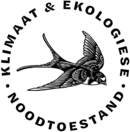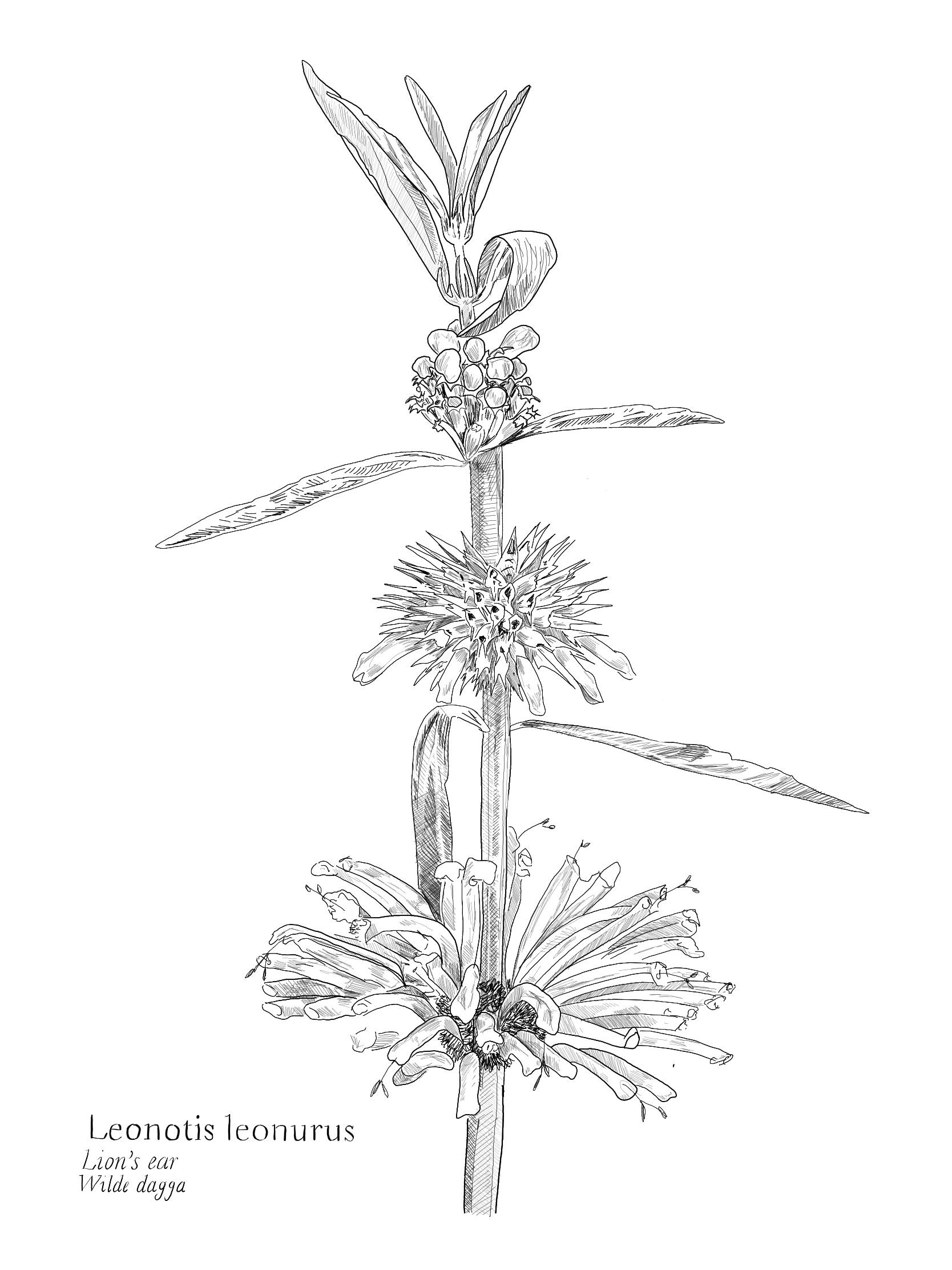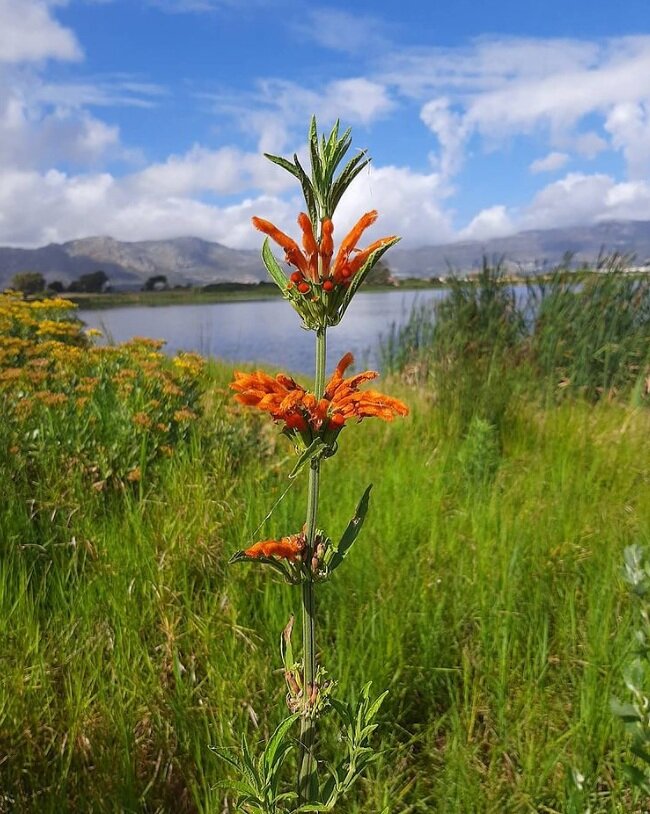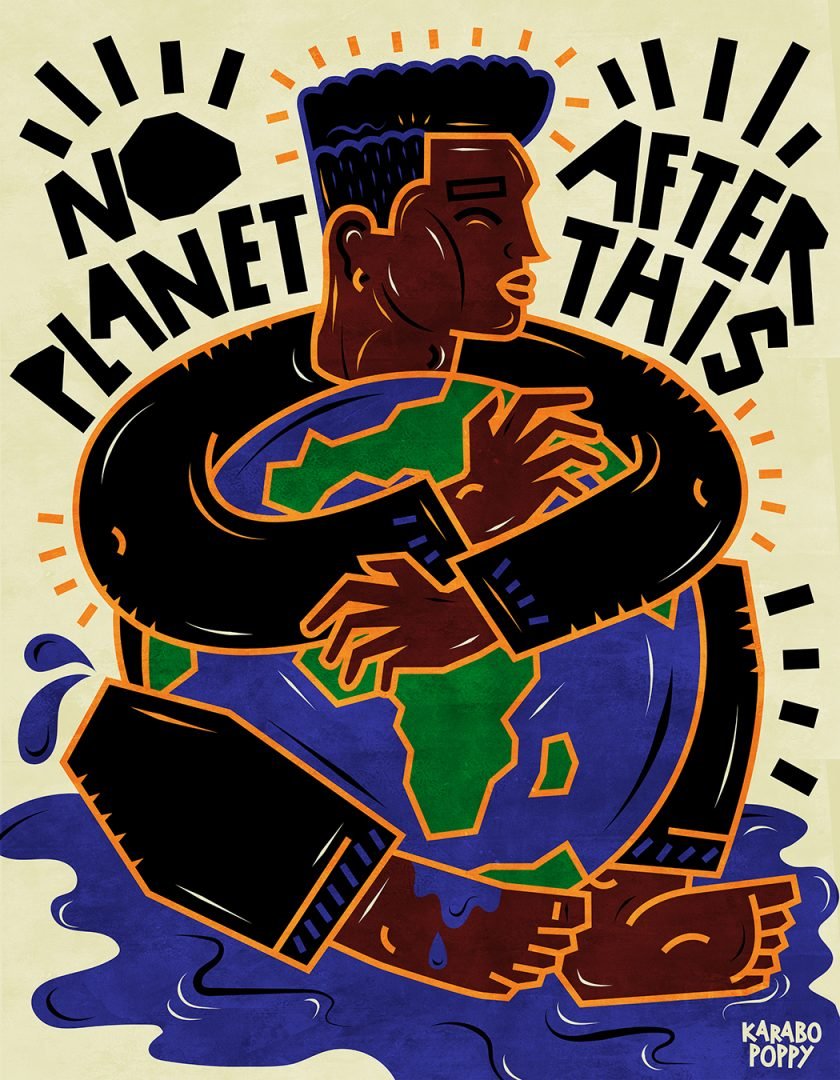Te midde van die plante by Princess Vlei
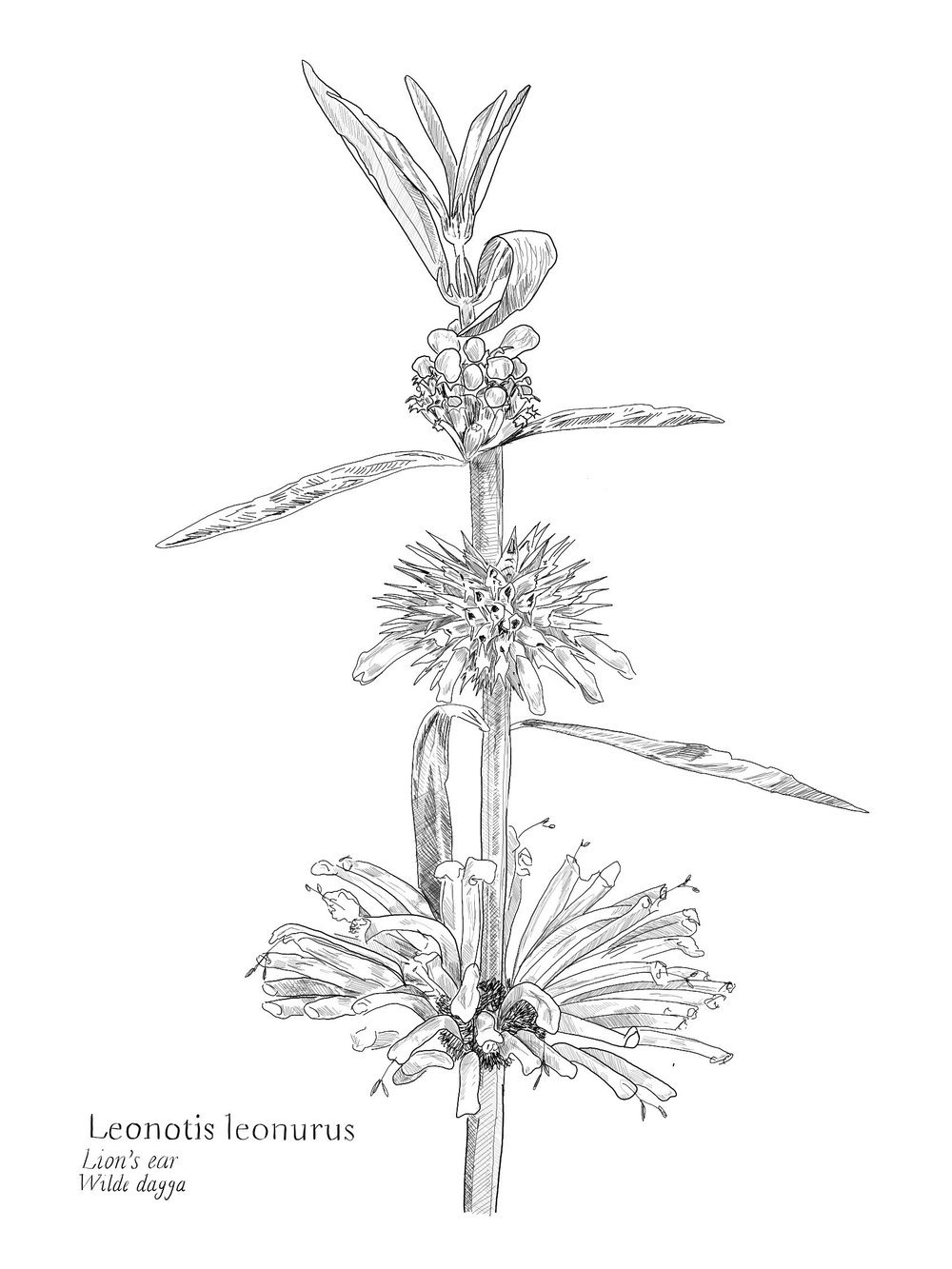
Illustrasies: Carla de Beer
Denisha Anand oor 'people of colour and green spaces'
“In the Western tradition there is a recognised hierarchy of beings, with, of course, the human being on top — the pinnacle of evolution, the darling of Creation — and the plants at the bottom. But in Native ways of knowing, human people are often referred to as ‘the younger brothers of Creation’. We say that humans have the least experience with how to live and thus the most to learn — we must look to our teachers among the other species for guidance.”
― Robin Wall Kimmerer, Braiding Sweetgrass: Indigenous Wisdom, Scientific Knowledge, and the Teachings of Plants
Princess Vlei strek deur Lotus River, Grassy Parks en Strandfontein in die Kaap. Die vlei is na ’n Khoiprinses vernoem wat volgens die legende en oorvertellings deur Portugese seevaarders ontvoer is terwyl sy in die vleiwaters gebad het. Die vlei, wat enorme waarde tot die omgewing bydra deur water te suiwer voor dit die see invloei, word al vir dekades lank deur die plaaslike gemeenskap bewaar en benut. Die vleiland is steeds ’n belangrike Khoiherdenkingsgebied, sowel as ’n bewaarplek vir die gemeenskapsidentiteit wat in die biodiversiteit van die omgewing gegrond is.
Omgewingsbewaarders soos Denisha Anand verrig noodsaaklike werk om ontwrigte natuurlike gebiede te restoureer. Denisha is ’n omgewingskundige, -navorser en -opvoeder. As biodiversiteitprojekbestuurder van die Princess Vlei Forum werk sy aan die rehabilitasie en bewaring van hierdie 109-hektaar-vleilandsisteem wat gedurende en ná apartheid verwaarloos is en in onlangse jare deur ’n winkelsentrumontwikkeling bedreig is. Sy is ook besig met ’n meestersgraad in omgewingsgeesteswetenskappe by die Universiteit van die Wes-Kaap, met ’n fokus op intergenerasionele plant-mens praktyke. Sentraal tot haar werk en navorsing is die strewe om die verhouding tussen gemarginaliseerde gemeenskappe en die omgewing te herstel. Sy fokus veral op omgewingsopvoeding onder kinders.
Denisha Anand, biodiversiteitprojekbestuurder van die Princess Vlei Forum
Onder apartheidswetgewing was Princess Vlei een van die min natuurlike gebiede wat toeganklik was vir Bruin en Swart persone ná talle gemeenskappe onder die Groepsgebiedewet na alternatiewe behuising op die Kaapse Vlakte verplaas is. Princess Vlei het ook onder andere bekend gestaan as “Claremont Beach” en “Gala Land”. Gedurende hierdie tyd is die omgewing geweldig afgeskeep deur die Kaapstadowerhede. Aansienlike ekologiese skade is aangerig toe Prince George Drive deur die vlei gebou is. Die skade wat die vleiland tot dusver deurgaan het, kan grotendeels toegeskryf word aan die blywende nadelige impak van apartheidsgedrewe stadsbeplanning tesame met winsgemotiveerde besluitneming aangaande die welstand van natuurlike ekosisteme in Kaapstad.
In 1998 is die biodiversiteit van die vlei verder bedreig deur die moontlike konstruksie van ’n kommersiële winkelsentrum. Die ontwikkelingsplanne is sterk teengestaan deur die plaaslike gemeenskap. In 2008 is die Dressing the Princess-projek gestig om die vleiland te rehabiliteer deur inheemse fynbos te plant, uitheemse plantspesies — soos Rooikrans en Port Jacksons, wat in die 19de eeu geplant is om die grond te help stabiliseer — te verwyder, wandelpaadjies te bou, en rommel op te ruim. In reaksie op die Princess Vlei-gemeenskap se pogings om die biodiversiteit van die area te bewaar en ontwikkelingsplanne te bestry, het die stad Kaapstad die ontwikkelaars se oorspronklike aansoek om die grond te hersoneer tot ’n kommersiële gebied, afgekeur. Die toutrek tussen die stad, ontwikkelaars en die plaaslike bewaarders van die land het in die daaropvolgende jare voortgeduur.
Die bewaring en rehabilitasie van die Princess Vlei-gebied word deur ’n ambisieuse gemeenskapsbegeleide vyf-jaar-restourasieplan verteenwoordig. Hierdie plan, wat onder andere die ontwikkeling van ’n omgewingsopvoedingsentrum, ’n Khoigedenkmonument, ’n buitelugmark, ’n amfiteater en staproetes insluit, behoort ’n aansienlike gedeelte van die land die kans te gee om te herstel. Hierdie projek is een van die grootste gemeenskapbegeleide massabewaringspogings in die Kaapse Floristiese Streek. ’n Deel van die organiseerders van die rehabilitasieprojek se fokus is om 5-10 hektare van drie bedreigde habitatsoorte te hervestig, wat onder andere insluit om 17 bedreigde spesies opnuut met die bewaringsgebied bekend te stel. Saailinge word deur skool- en gemeenskapsgroepe in die plaaslike omgewing geplant en na omgesien. Omgewingsopvoeding en -kuns speel ’n kritiese rol in die sukses van die projek.
Die hegte band tussen die gemeenskap en die landskap van Princess Vlei dien as bewys van die historiese en kulturele waarde wat aan die mens se verhouding met die natuur gekoppel is. Die vleiland dien nie net as habitat vir ’n wye verskeidenheid endemiese en bedreigde spesies nie, maar bied ook ’n noodsaaklike ruimte vir stedelike gemeenskappe om in verbintenis met die natuurlike omgewing te tree, sowel as om ’n liefde en waardering vir die lewende wêreld te kweek onder kinders.
“... ’n noodsaaklike ruimte vir stedelike gemeenskappe om in verbintenis met die natuurlike omgewing te tree, sowel as om ’n liefde en waardering vir die lewende wêreld te kweek onder kinders.”
Projekte soos hierdie een is belangrik, want tesame met die vergrotende verdeeldheid tussen die mens en die omgewing, is menslike druk op natuurlike hulpbronne voortdurend aan die toeneem. Daar is ’n dringendheid vir menslike stelsels en stedelike strukture om meer volhoubaar en bewustelik met natuurlike ekosisteme om te gaan. In Westerse ruimtes is daar nogtans ’n oorheersende sentiment dat die mens verhewe is bo die natuur. Waar kom hierdie idee vandaan? Dat die mens belangriker as ander lewende wesens is? As ’n vereenvoudigde antwoord hierop kan daar verwys word na die bekende formulering van René Descartes: “I think, therefore I am”. Hierdie stelling, en die binêre klassifikasie van menslike en nie-menslike ekosisteme wat daardeur geïmpliseer word, het die weg gebaan vir die dualistiese siening van die lewende wêreld wat vandag steeds sentraal staan in ons verstaan van die kolonialiteit van die natuur. Hierdie dualisme het die Westerse grondslag geskep wat die gees van die liggaam skei, en wat die mensdom van die natuur skei.
“In Westerse ruimtes is daar nogtans ’n oorheersende sentiment dat die mens verhewe is bo die natuur. Waar kom hierdie idee vandaan?”
Deur die mens as meerderwaardig teenoor die “natuur” (’n konsep waarvan die definisie en grense hersien moet word — die mens is immers deel van die natuur, en behoort daarom nie as apart hanteer te word nie) te stel, word ’n uitbuiting van mag geregverdig. Sodoende word ’n ekologiese hiërargie tot stand gebring waarvolgens die nie-menslike wêreld in die posisie van die Ander ge-cast word — ’n objek wat oorwin en uitgebuit kan word.
Mary Graham bied ’n inheemse ekwivalent vir Descartes se stelling: “I am located, therefore I am.” “Locality” in hierdie sin verwys na die verhouding tussen die mens en die landskap waarvandaan ons afkomstig is; die identiteit en karakter wat in die landskap gewortel is. Hierdie gesprek kan egter nie plaasvind sonder om te oorweeg hoe mag en kennis in die verlede en die hede gekoloniseer is nie. In inheemse kennis word mense as déél van die natuur erken en dit verteenwoordig ’n holistiese manier van bestaan in die wêreld, waar plek, taal, gemeenskap en spiritualiteit intrinsiek met mekaar verweef is.
“In inheemse kennis word mense as déél van die natuur erken en dit verteenwoordig ’n holistiese manier van bestaan in die wêreld, waar plek, taal, gemeenskap en spiritualiteit intrinsiek met mekaar verweef is. ”
Hoe kan die koloniale houvas op natuurlike ruimtes afgetakel word? Hoe kan die kollektiewe landskapsidentiteit van gemarginaliseerde gemeenskappe herwin word, tesame met die bewaring van inheemse biodiversiteit? Hoe kan plaaslike veldkennis ingespan word om kinders te leer hoe hulle van die natuur deel vorm? Hoe kan ons volhoubare bewaarders van die aarde word?
Denisha deel haar insig en kennis — ook oor die konsep van die Planthroposcene wat gebaseer is op die poging om van die volhoubaarheidsretoriek van die Antroposeen afskeid te neem en in stede daarvan te kies om die omgewingskrisis deur ’n ekosentriese instelling te benader.
ELODI: What does your work at Princess Vlei entail, and what is the ecological value of the site in terms of biodiversity and indigenous plant and animal life in the area?
DENISHA: I’ve been working at Princess Vlei since 2017. Princess Vlei is a 109-hectare biodiversity agreement site in the City of Cape Town and it is one of the city’s largest public open spaces that can be accessed for free. It’s not necessarily a nature reserve, but it is a biodiversity area, which means that conservation and biodiversity care maintenance is needed. There are two endangered vegetation types that I work with, one critically endangered, and one endangered. This is why the site has to be a conservation area, even though it falls under Parks and Recreation. Usually, these spaces fall under environmental services, but our park falls under Parks and Recreation. With town-planning issues from the past, these areas usually don’t fall under the right management directive.
I do alien clearing as part of my conservation work because the site is infested with intruder species and stuff that doesn’t belong there. The other part of my work is the community aspect of it. I work with a lot of schools in the local community to build a relationship between the youth and the vlei; to foster connection between people of colour and green spaces in marginalised communities. Because of the extreme neglect of green spaces in marginalised communities, you find that these spaces become severely criminalised, and they have really bad stigmas attached to them. This is very sad because there’s so much indigenous culture connected to green spaces.
What we’re trying to do is to break down that stigma by bringing the kids to the vlei and teaching them about the environment. We have the conversation about their ancestors and their links to the Khoi and all the people who came to South Africa on the ships, and how they didn’t just, you know, end up on the Cape Flats. All of that goes into our environmental education to create a kind of spatial awareness, and, most importantly, to connect them directly to the land via their ancestors. That’s the only way you can really do it when everything else around you — your income bracket, your ability to access these spaces, society, everything — is telling you that you don’t belong, you don’t look the type to enjoy green areas. So we teach children that you do belong in these spaces, and you are the type to enjoy these places, simply because your ancestors link you directly to this land. This land is yours to enjoy.
“We have the conversation [with children] about their ancestors and their links to the Khoi and all the people who came to South Africa on the ships, and how they didn’t just, you know, end up on the Cape Flats.”
ELODI: You work with children to teach them about their place in the environment and how they can protect it. Do you find that children are more susceptible to environmental education than adults? At the core of it, the human’s place in nature is actually a very simple concept. How do you talk to children about this?
DENISHA: Children are definitely more open to it. And they’re easy to influence because a lot of kids are at that stage where they haven’t numbed themselves to society and to the surroundings. So they’re more open to listening to how change can be brought about in the communities, while the adults are often like, you know: “Keep quiet, this is not Constantia.” Starting the conversation by asking children what they would like in their communities, a lot of them say they just want to feel safe playing outside and they want open spaces to enjoy. They want to play outdoors without feeling threatened, without hearing gunshots in the background.
They notice the issues in terms of pollution and criminal activity in open spaces. And so those are the perceptions of the environment. And then we go in and we first ask, is there a way? How do we change this? We don’t want to make them feel helpless, because we can’t change the community situation. But the one space that we can change is the school grounds because it’s a safe, controlled environment. So that’s what we try to do. A lot of those kids spend the weekends and holidays at schools, like our eco kids who come on a Friday after school and work through the afternoon, or even on a Saturday. They spend all their time at school because it’s just safer.
It’s also about the visibility of the sacred spaces in these areas. It just does something to your mind when you see green; it just calms and consoles people. Just having more clean green spaces to look at is revolutionary for these kids.
“Teach the children. We don’t matter so much, but the children do. Show them daisies and the pale hepatica. Teach them the taste of sassafras and wintergreen. The lives of the blue sailors, mallow, sunbursts, the moccasin flowers. And the frisky ones ― inkberry, lamb’s-quarters, blueberries. And the aromatic ones ― rosemary, oregano. Give them peppermint to put in their pockets as they go to school. Give them the fields and the woods and the possibility of the world salvaged from the lords of profit. Stand them in the stream, head them upstream, rejoice as they learn to love this space they live in, its sticks and leaves and then the silent, beautiful blossoms. Attention is the beginning of devotion.”
― Mary Oliver, Upstream: Selected Essays
ELODI: Ecological education among children is very needed, especially considering the lack of indigenous knowledge in mainstream/Western education material. You have spoken about making histories more accessible to children; fostering belonging and intergenerational learning about indigenous plant knowledge and medicines. How was your knowledge and understanding of biodiversity shaped by environmental education when you were young? Was there someone in your life who took a special interest in teaching you about the environment?
DENISHA: I’ve always had a keen interest in biodiversity. As a child, I was obsessed with the ocean. I would go to the library and take out all the books I could find. My dad was working for the ambulance service at the time. And then he started working for the rescue services as a diver. He was one of the only people of colour in that circle at the time who was doing those things. So I’d go along with him and his friends. We’d be out at the ocean, and they would be scuba diving. We would also go hiking a lot. It was that parental exposure. But I mean, it was an innate thing. Even if my dad wasn’t around, it was something that I was always connected to. As a young child going to the public library, this is what I liked to go and read about.
There was my bio teacher as well. She encouraged me to go to the Two Oceans Aquarium because they were doing this young biologist course. I started the course when I was in grade nine. I did the training and got to volunteer many hours at the aquarium. Then I started working in the environmental education department when I was in matric. I started doing educational sleepovers and helping out on Saturdays and during school holidays. I showed an interest and I was lucky enough to have someone who saw that. That’s why environmental education and eco teachers and external educators are so important.
ELODI: The community vision for Princess Vlei is an incredible plan — fynbos rehabilitation, an environmental education centre, a Khoi memorial, an outdoor market, walkways, hiking trails… How is this vision progressing? What are the biggest obstacles?
DENISHA: We’ve got a five-year restoration management plan, that we’ve privately funded ourselves because the city didn’t have the capacity to assist us with that. We’ve employed a private restoration practitioner, someone who propagates all our clients, who does everything for us, basically. And we do this through private funding. This plan is the most important thing to any rehabilitation. That was a big success for us because most of these areas don’t have restoration management plans.
When you’re working in private communities, or Black communities that have been severely neglected, there’s just no capacity or drive to want to restore the space. And the only way you can actually restore it is by creating a restoration plan. So we wanted to get that done. And we’ve got it done. We’ve been working. So all the work that I do and all the work that we do on-site speaks to that plan. In the past, local government was just saying, “it’s just random people planting stuff. It’s not really conservation. It’s just like a community gardening kind of thing…” Even though we know that we’re using the right plants and plugging them in the right spaces. But now with the restoration management plan, everyone takes us seriously because it’s an official document and it has also been sponsored by the Society for Ecological Restoration.
ELODI: Can you tell me more about your studies’ focus on intergenerational plant-human relations and restoring the relationship between marginalised communities and the natural environment? How does your research tie in with the work you do at Princess Vlei?
DENISHA: In my master’s, I work with biosemiotics, which is about looking at the world through signs and symbols. For example, wild rosemary is an indigenous plant, it’s got these beautiful wildflowers. But, to a person of colour who lives on the Cape Flats, an overgrown wild rosemary bush is a sign and a site of crime and rape. Nature starts looking like different things because of the legacies of apartheid. And we have to take that into consideration. And so what that means for us in terms of conservation management, is that we have to cut down certain bushes to knee-length because we have to anticipate that these are possible hotspots for criminality.
“Nature starts looking like different things because of the legacies of apartheid.”
Working with the reality on the ground, we’re trying to preserve biodiversity while not being too precious about saving the plants and saving the world; finding a middle ground when it comes to maintenance and considering the legacies of apartheid and what green spaces have become. For example, dune systems on the Cape Flats. Nobody goes there because of criminal activities. But if you go to Blouberg and up the West Coast, dune systems are these beautiful, amazing spaces to enjoy. But we’ve also got dune systems on the Cape Flats, that’s why it’s called the Cape Flats. So it’s about looking at how these spaces have become criminalised because of the lack of maintenance and management.
Kankerbos in Princess Vlei (Foto: @theplanthropologist)
Wilde dagga in Princess Vlei (Foto: @theplanthropologist)
ELODI: You’ve written about undoing the colonial idea that people are entitled to green spaces based on economic status; the idea that some areas are more worthy of protection and restoration than others. Coloniality is so visible in green spaces — on the surface level, it can be seen in the density of trees and plant growth in neighbourhoods and access to well-maintained public green spaces. Of course, the effects of coloniality reach much deeper and further than what meets the eye. Identity, cultural heritage, language and knowledge are all intricately rooted in human-nature relations. Considering the violent histories and continued impact of apartheid town planning and colonial environmentalism on marginalised communities in South Africa, how can conservation practices be more consciously centred on belonging and justice? Can you share more about your intersectional environmental approach to biodiversity conservation, in particular at Princess Vlei?
DENISHA: Princess Vlei is a provincial heritage site as well as a biodiversity agreement site. We consider both those aspects of the site when we do restoration. So a simple thing that we do when planting fynbos is to plant culturally relevant species. So we plant things like kankerbos and wilde dagga. We want to bring back the waterblommetjie as well. Back in the day, the vlei wouldn’t have been one water body. There were main water bodies and then there were seasonal water bodies all around them. The more seasonal water bodies you have, the more diversity you have. We are bringing that back. Waterblommetjie is eaten by locals who make waterblommetjiebredie. Cancer bush is a medicinal plant that everyone in the area uses for high blood pressure and diabetes. Wilde dagga as well.
Older people are difficult to connect with because of these walls that they’ve already built up. When they see things like that, as we plant these species, they can relate to it because of their childhood; those are the medicines that they would use and that is the food they would eat. They get nostalgic about it and it opens up a conversation — this is also why we do restoration. So we can bring these culturally relevant species back. That’s not necessarily just about conservation, it’s also considering which species were lost because of apartheid neglect in these spaces. The focus is not only on the conservation status of certain species, but giving back species that mean something to these people.
Green distribution and the lack of management in spaces in close proximity to Black and Brown bodies is intentional for me. Apartheid town planning was all about creating spaces where people of colour would live as sub-human. Making green spaces unsafe and not maintaining these spaces is part of creating sub-human conditions. We know that apartheid town planning was all about removing green to create these concrete spaces where crime and violence would thrive. There’s a lot of psychological research on the impacts of greenery and natural spaces on the psyche of children. Apartheid psychology and town planning were informed by racist science. So they knew what they were doing.
What we walked into at Princess Vlei was racialised neglect. Because it had been so badly neglected, the city of Cape Town was trying to sell it, like what they do to all green spaces in the city. It gets so badly neglected that you can’t fix it anymore. So you put up a mall or a parking lot or something. And they were going to do that at Princess Vlei. Luckily, the community fought back against that. There’s a long history.
ELODI: Buzzwords like “sustainability”, “green”, “eco-friendly”, “environmentally responsible”, etc. are easily thrown around these days. As many people are becoming more aware of the impact of their actions on the environment, corporations are also increasingly exploiting these concerns to win consumers over. This also ties in with this notion that individual action can combat climate change rather than systemic change from governments and big corporations. What does sustainable living encompass for you?
DENISHA: So much pressure is placed on the individual to do more to save the planet. It gets to a point where you are just so fatigued because there’s not much we can do. A lot of people think that you need to buy your way out of the crisis; buying certain things in order to be “green”. But it’s about living a slower life. There’s this concept called “tree time” where you mimic plant time to do things slowly. That’s what I have been trying to do, live slowly.
You also can’t have this conversation without considering privilege. To be able to choose a certain lifestyle within the sustainability conversation is to be privileged, because you can’t have this conversation with people on the ground. You can’t expect anything from them because they are bearing the brunt of the system that we’re talking about. For me, sustainability is reverting back to old ways of cooking your food instead of buying it; slowing down to actually do that. Growing your own food, if you can, instead of buying it. It’s a slow process.
“There’s this concept called ‘tree time’ where you mimic plant time to do things slowly. That’s what I have been trying to do, live slowly. ”
It’s such a tricky conversation to have, because sustainability can never be achieved through an individual’s concern, I think. If you do something that you consider sustainable, it’s your idea of hope for the environment. It’s just our personal way of hoping for better while fighting a bigger giant demon out there. For me, sustainability is a personal choice to have hope that things can change. I don’t think it can change a lot if we’re doing it on our own. We need to come together and push for systemic change. But you can change a little corner in the world. And that’s what we’re trying to do at Princess Vlei, protecting this corner that is a green lung on the Cape Flats.
“Observing wilde dagga and being seen by wilde dagga” (Foto: @vegetal_involutionist)
Denisha in Princess Vlei (Foto: @vegetal_involutionist)
ELODI: I read something you wrote about plants and trees as observers; how they “see” us. I have been thinking about this for a long time. This idea relates to the concept of the “Planthroposcene”, a term that was coined by Natasha Myers in reference to an aspirational episteme of living in solidarity with plants (and it’s also your Instagram name). How can we be custodians of the natural world?
DENISHA: Custodianship is essentially about coming together and caring about something. I don’t have an issue with people who are like: “I’m done buying this brand, because palm oil or something.” That’s their way of being a custodian of something. But it’s so privileged. And custodianship is simply to care. It’s an indigenous way of relating to land, because everything indigenous people did, and do, is about caring. It’s belonging to land; it’s identifying that you share common ancestry with land. Kinship with the land. You acknowledge that you and the land are inseparable. When the land is hurt, you’re hurt. It’s about an entirely different way of imagining the world. You imagine a world where plants are considered caregivers, almost like gods, in a way, because of how much they give us and how they hold the planet.
“[Custodianship is to] acknowledge that you and the land are inseparable. When the land is hurt, you’re hurt. It’s about an entirely different way of imagining the world. You imagine a world where plants are considered caregivers, almost like gods, in a way, because of how much they give us and how they hold the planet.”
In the Planthroposcene, we learn from plants as allies. Again, it’s going back to seeing yourself as inseparable from the land. The industrial era teaches us that humans are above plants, that plants can be dominated and exploited. Because the moment you belittle something, you can exploit it. I think one of the biggest issues with the current era of colonialism and neocolonialism is that it separates us from nature, and that nature is treated as a commodity. In the Planthroposcene, you see yourself as equal to everything that is not human.
Eerste en oudste Afrikaanse tydskrif, sedert 1896
Ons bou aan ’n moderne beeld van hoe Afrikaanswees lyk, lees en klink. Het jy van Te midde van die plante by Princess Vlei gehou? Dan ondersteun ons. Vriende van Klyntji word op hierdie bladsy gelys.